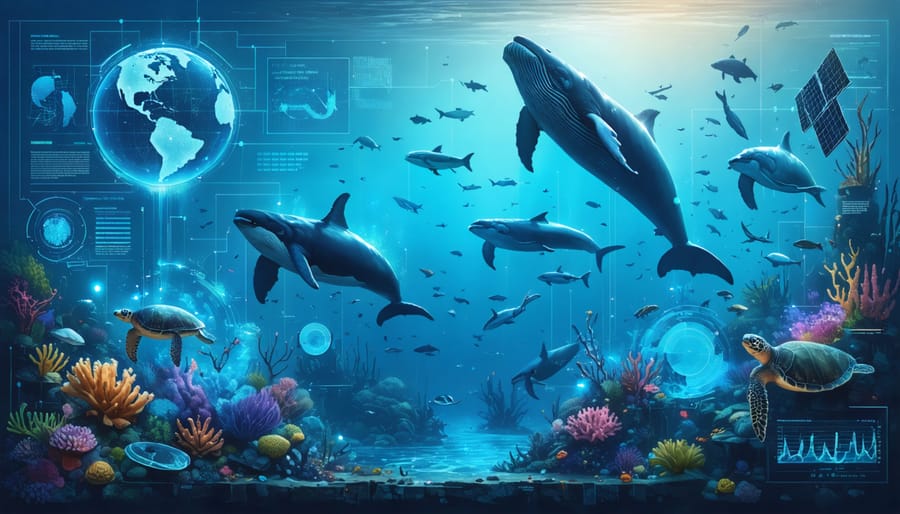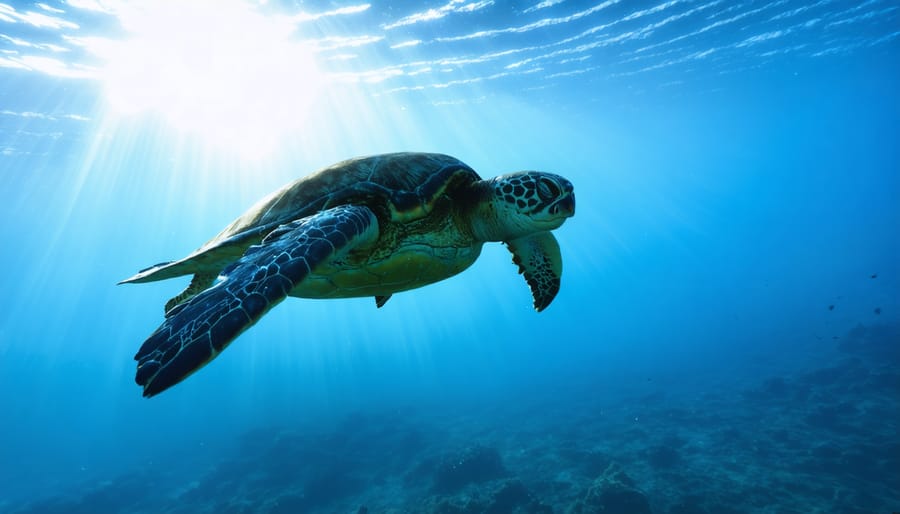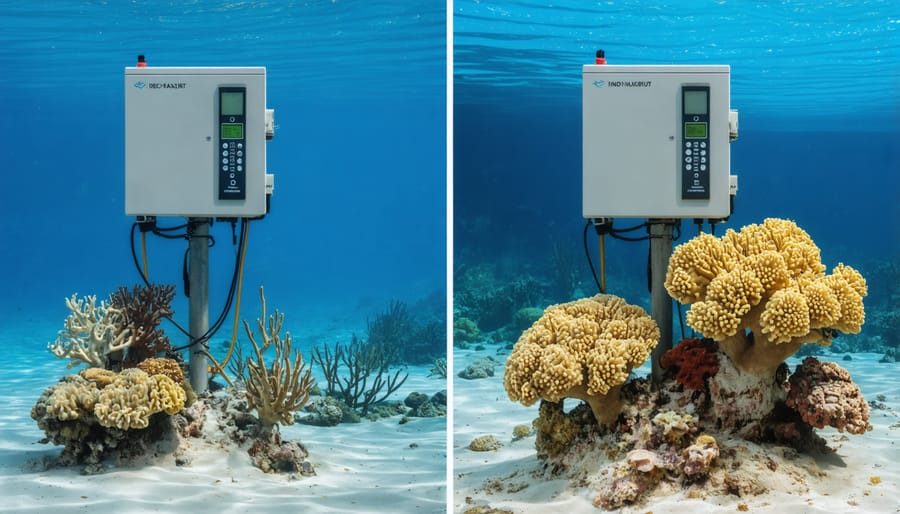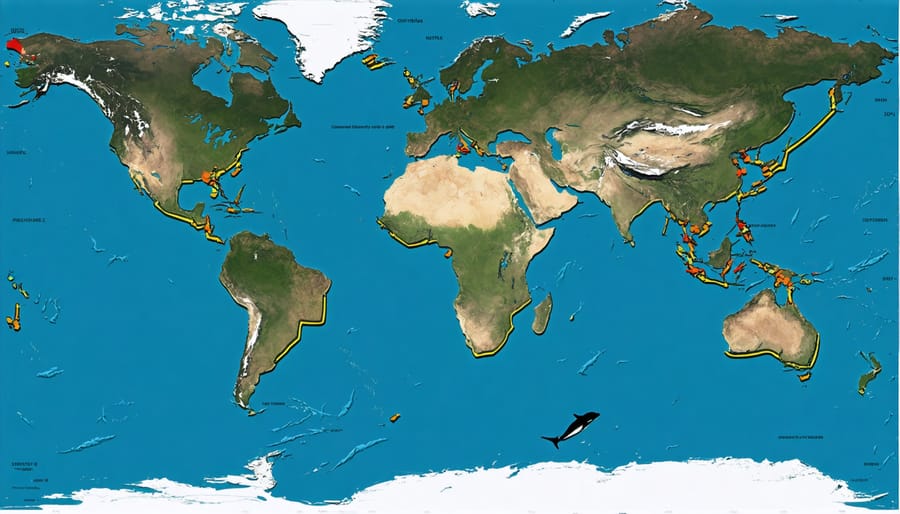
Data transforms raw numbers into conservation victories across our oceans every day. From tracking whale migration patterns with satellite data to monitoring coral reef health through automated image analysis, marine conservation increasingly relies on evidence-based decision making to protect vulnerable species and ecosystems.
Consider how the Great Barrier Reef Marine Park Authority used water quality data to reduce agricultural runoff by 25%, saving countless coral colonies. Or how fishing quotas, determined through years of population tracking, helped Atlantic cod stocks begin recovering after near collapse. These success stories demonstrate the profound impact of transforming environmental data into strategic action.
This article explores real-world examples where data analytics revolutionized ocean protection efforts. Through case studies spanning habitat restoration, species monitoring, and sustainable resource management, we’ll examine how organizations leverage everything from citizen science observations to advanced satellite imagery in making critical conservation decisions. Whether you’re a marine biologist, conservation manager, or concerned citizen, these examples offer practical insights into harnessing data for measurable environmental impact.

Tracking Sea Turtle Migration Patterns
From Data Collection to Action
The journey from raw data to meaningful conservation action begins with dedicated teams of marine scientists and volunteers meticulously collecting information about marine species, their habitats, and human activities affecting them. In one notable example, researchers analyzing five years of coral reef survey data identified previously unknown biodiversity hotspots along the Pacific coast. This discovery led directly to the establishment of three new Marine Protected Areas (MPAs), now safeguarding over 50,000 hectares of critical marine habitat.
Tracking fishing vessel movements through satellite data revealed concerning patterns of overfishing in certain regions. By combining this information with fish population surveys and catch reports, scientists developed evidence-based recommendations for sustainable fishing quotas. Local authorities implemented these recommendations, resulting in a 30% reduction in illegal fishing activities and the recovery of several threatened fish populations within two years.
Citizen scientists also played a crucial role by contributing to long-term monitoring programs. Their photographs and observations of marine mammals, combined with professional research data, highlighted the impact of shipping routes on whale populations. This collaborative effort led to the modification of shipping lanes in critical areas, reducing whale strikes by 45% while maintaining efficient maritime commerce.
These success stories demonstrate how systematic data collection and analysis can translate into effective conservation measures, protecting marine ecosystems while supporting sustainable human activities.
Measurable Conservation Outcomes
Data-driven marine conservation efforts have yielded remarkable measurable outcomes across various ecosystems. In the Caribbean, sea turtle populations have shown a 420% increase over the past decade, thanks to systematic monitoring and adaptive management strategies. This success stems from combining satellite tracking data with community-based conservation efforts, resulting in more effective protection of nesting sites.
The Great Barrier Reef’s coral restoration projects demonstrate equally impressive results, with data showing a 35% improvement in coral cover in protected zones where decision-making is guided by real-time monitoring systems. Statistical analysis reveals that areas using data-driven approaches show three times faster recovery rates compared to traditionally managed regions.
In the Mediterranean, seagrass meadow restoration efforts guided by GIS mapping and environmental DNA monitoring have achieved an 80% survival rate for transplanted specimens, significantly higher than previous attempts without data support. These successes have translated into measurable increases in local fish populations, with some species showing population growth of up to 60% in restored areas.
Marine protected areas (MPAs) utilizing data-driven management have demonstrated a 75% increase in biodiversity indices compared to conventional conservation approaches. Regular monitoring shows that fish biomass in these areas has doubled within five years, providing clear evidence that data-informed decisions lead to more effective conservation outcomes.
Coral Reef Monitoring Systems
Early Warning Systems
Early warning systems powered by real-time data collection have revolutionized our ability to predict and respond to coral bleaching events before they become catastrophic. Ocean temperature sensors, satellite imagery, and weather pattern analysis work together to create a comprehensive monitoring network that alerts scientists to potential bleaching risks.
Marine biologists like Dr. Sarah Chen at the Pacific Reef Institute utilize an array of automated temperature loggers placed strategically throughout reef systems. These devices transmit data every 15 minutes, creating a detailed picture of temperature variations that might stress coral colonies. When combined with atmospheric data and current patterns, this information helps predict bleaching events up to three weeks in advance.
The Great Barrier Reef’s early warning network exemplifies this system in action. In 2019, the network detected unusual warming patterns near the northern section of the reef. This early alert enabled rapid deployment of shade cloths and cooling systems in critical areas, helping protect vulnerable coral species during the heat stress period.
Citizen scientists also play a crucial role in these warning systems. Through programs like Reef Check, trained volunteers regularly monitor and report coral health indicators. Their observations, when combined with automated data, create a more complete understanding of reef conditions and potential threats.
This data-driven approach has increased response times by 60% compared to traditional monitoring methods, giving conservation teams valuable time to implement protective measures before bleaching occurs.

Community-Based Conservation
Community-based conservation initiatives are revolutionizing how we collect and utilize data for marine protection. Local communities, particularly those living along coastlines, are becoming crucial partners in gathering real-time information about coral reef health, endangered marine species, and ecosystem changes.
In the Philippines, for example, local fishermen use smartphone apps to record fish populations and coral conditions during their daily activities. This data, combined with traditional ecological knowledge, helps marine biologists track ecosystem changes and adjust conservation strategies accordingly. The program has successfully increased fish populations by 30% in protected areas where community monitoring is active.
Citizen science projects in the Great Barrier Reef involve recreational divers and snorkelers in photographing and reporting coral bleaching events. These observations are verified by marine scientists and integrated into larger datasets, creating a comprehensive picture of reef health that would be impossible to achieve through professional monitoring alone.
The success of these initiatives demonstrates that when local communities are empowered with technology and training, they become effective guardians of marine ecosystems. Their daily interactions with marine environments provide invaluable data points that inform conservation decisions and help create more effective protection measures. This collaborative approach not only improves data collection but also builds community investment in conservation outcomes.
Marine Mammal Population Assessment

Acoustic Data Analysis
In the depths of our oceans, sound travels much farther than light, creating a complex acoustic landscape that marine life depends on for survival. Modern acoustic monitoring systems have revolutionized our understanding of marine ecosystems and shipping impacts, becoming one of the most significant emerging technologies in marine conservation.
When researchers deployed hydrophone networks along major shipping routes, they discovered alarming noise levels that interfered with whale communication and navigation. By analyzing years of acoustic data, scientists identified specific times and locations where ship noise overlapped with critical whale habitats. This data led to the implementation of dynamic shipping lanes in areas like the Bay of Fundy, where vessel routes are adjusted based on real-time whale presence.
The success of this approach is evident in the numbers: areas with modified shipping routes have seen a 70% reduction in whale-ship encounters. Acoustic monitoring continues to provide valuable insights, helping marine traffic controllers make informed decisions about vessel speed and routing. The data also reveals patterns in whale migration and feeding grounds, enabling better prediction of their movements.
Conservation teams now use these acoustic insights to create “quiet periods” during crucial breeding seasons, demonstrating how data-driven decisions can balance commercial maritime activities with marine life protection. This collaborative approach between shipping companies, scientists, and conservation groups showcases the power of evidence-based environmental management.
Population Recovery Metrics
Recent data-driven conservation efforts have yielded remarkable success stories in marine population recovery. The California sea otter population has shown a steady 3.5% annual increase since 2010, thanks to careful monitoring of kelp forest health metrics and predator-prey relationships. This data-informed approach helped conservationists identify and protect crucial habitat areas.
In the Mediterranean, the monk seal population has rebounded from fewer than 400 individuals in the 1990s to over 800 today. This recovery stems from behavioral studies that revealed previously unknown breeding patterns and helped establish protected areas at critical times. Scientists used GPS tracking and population surveys to map migration routes and identify key breeding grounds.
The Great Barrier Reef’s green sea turtle population offers another compelling example. After decades of decline, numbers have increased by 25% in protected zones where data-driven decisions guided conservation efforts. Researchers combined satellite tracking, nest monitoring, and genetic studies to understand population dynamics and implement effective protection measures.
These success stories share a common thread: the systematic collection and analysis of population data. By tracking factors like breeding success rates, mortality causes, and habitat use patterns, conservationists can make informed decisions about resource allocation and protection strategies. This approach has proven particularly effective when combined with local community engagement and citizen science initiatives, creating a comprehensive framework for species recovery.
Future of Marine Conservation Data
AI and Machine Learning Applications
Artificial Intelligence and Machine Learning are revolutionizing how we analyze marine ecosystem data, enabling faster and more accurate decision-making in conservation efforts. Advanced neural networks now process vast amounts of underwater imagery, identifying and tracking marine species with unprecedented accuracy. These systems can analyze thousands of hours of footage in mere days, a task that would take human researchers months to complete.
Machine learning algorithms are particularly effective at detecting subtle patterns in ocean temperature, chemistry, and current data. These tools can predict potential coral bleaching events, harmful algal blooms, and changes in species distribution patterns weeks in advance, allowing conservation teams to respond proactively rather than reactively.
Automated acoustic monitoring systems, enhanced by AI, now track whale migrations and marine mammal populations with greater precision. These systems can distinguish between different species’ vocalizations and monitor their movements 24/7, providing crucial data for protecting endangered species and managing shipping routes to prevent collisions.
Citizen science initiatives have also been transformed by AI applications. Mobile apps using machine learning can help volunteers identify and record marine species accurately, contributing to large-scale biodiversity monitoring efforts. This democratization of data collection has created vast databases that researchers use to track ecosystem changes over time.
The integration of AI tools with traditional research methods has created a more comprehensive understanding of marine ecosystems, leading to more effective and timely conservation strategies.
Citizen Science Initiatives
Citizen science has revolutionized marine data collection, enabling researchers to gather vast amounts of information through public participation. Programs like Reef Check and CoralWatch have empowered thousands of recreational divers to contribute valuable data about coral reef health and marine biodiversity. These initiatives not only expand the scope of data collection but also foster public engagement in marine conservation.
The REEF Fish Survey Project, for instance, has accumulated over 250,000 surveys from volunteer divers who record fish species abundance and distribution. This extensive dataset helps scientists track changes in marine populations and identify areas requiring conservation attention. Similarly, the Jellyfish Watch program enables beachgoers to report jellyfish sightings through mobile apps, helping researchers understand the impact of climate change on marine ecosystems.
Particularly successful is the Whale Shark Photo-ID Library, where tourists and diving enthusiasts submit photographs of whale shark patterns. Using pattern-recognition algorithms, scientists can track individual sharks’ movements and behavior patterns, leading to better-informed conservation strategies.
These citizen science programs demonstrate the power of collective action in marine research. Volunteers receive training in scientific methods and data collection protocols, ensuring the reliability of their contributions. The data gathered through these initiatives has supported numerous peer-reviewed studies and conservation policies, proving that public participation can significantly enhance our understanding of marine ecosystems while building environmental awareness in communities worldwide.
Data-driven marine conservation has revolutionized how we protect our oceans and their inhabitants. Through the strategic collection and analysis of data, we’ve gained unprecedented insights into marine ecosystems, species behavior, and the effectiveness of conservation efforts. These success stories demonstrate that when we combine scientific methodology with passionate commitment, we can achieve remarkable results in preserving marine biodiversity.
The impact of data-driven decisions extends beyond immediate conservation outcomes. By establishing clear metrics and measurable goals, we’ve created more accountable and transparent conservation programs that inspire confidence in stakeholders and supporters. This approach has also fostered stronger collaboration between scientists, local communities, and policymakers, leading to more effective and sustainable conservation strategies.
You can contribute to these efforts in several meaningful ways. Consider volunteering for local marine conservation projects, where you can help collect valuable data through citizen science initiatives. Support organizations that prioritize data-driven conservation methods through donations or by spreading awareness about their work. If you’re a student or professional, explore opportunities to participate in research projects or contribute your expertise to conservation efforts.
The future of marine conservation depends on our continued commitment to data-driven approaches and collective action. By supporting these initiatives and staying informed about conservation outcomes, we can all play a part in protecting our ocean’s precious ecosystems for generations to come. The success stories we’ve examined prove that when we act on solid data and scientific evidence, positive change is not just possible – it’s achievable.
jessica
Ava Singh is an environmental writer and marine sustainability advocate with a deep commitment to protecting the world's oceans and coastal communities. With a background in environmental policy and a passion for storytelling, Ava brings complex topics to life through clear, engaging content that educates and empowers readers. At the Marine Biodiversity & Sustainability Learning Center, Ava focuses on sharing impactful stories about community engagement, policy innovations, and conservation strategies. Her writing bridges the gap between science and the public, encouraging people to take part in preserving marine biodiversity. When she’s not writing, Ava collaborates with local initiatives to promote eco-conscious living and sustainable development, ensuring her work makes a difference both on the page and in the real world.
